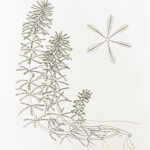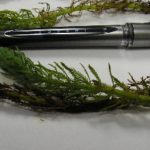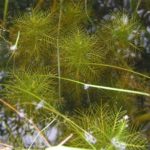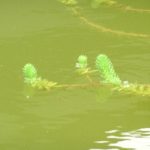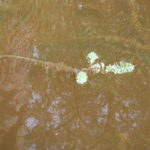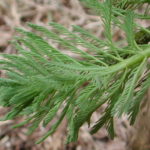Myriophyllum aquaticum
Non-Native
USDA, NRCS. 2018. The PLANTS Database (http://plants.usda.gov, 28 March 2018). National Plant Data Team, Greensboro, NC 27401-4901 USA.
Illustration courtesy of University of Florida/IFAS Center for Aquatic and Invasive Plants. Used with permission.
What is Parrot’s-feather?
Other common spellings and names include: parrot feather, parrot-feather, parrotfeather watermilfoil, water-feather, Brazilian watermilfoil.
Physical Characteristics
Leaves:
- Light-green to blue-green
- Long
- In whorls of 4 to 6
- Stiff
- 0.78-2 inches long
- Divided into 10 or more linear, thread-like sections
- Upper divisions: 0.13-0.25 inches long
- Less lower divisions than upper divisions
Stem:
- Branching
Flowers:
- Located in the axils of the leaves
- White or pinkish branches that look similar to feathers
Fruit:
- 0.06-0.13 inches long
- Not fertile in the United States
Reproduction:
- Only female plants in the United States
- Seeds are not produced in North America
- Fragments of rooted plants can produce new plants
Where Does it Grow?
EDDMapS. 2024. Early Detection & Distribution Mapping System. The University of Georgia – Center for Invasive Species and Ecosystem Health. Available online at http://www.eddmaps.org/; last accessed January 28, 2024.
Non-Native
Parrot’s-feather is a native of South America and was probably brought to the U.S. for the aquarium industry.
Parrot’s-feather can be found in freshwater streams, lakes, rivers, canals, and on seepage slopes.
Pros and Cons of Parrot’s-feather
This plant is not native to North America, but has naturalized in much of the United States. While it is not illegal to possess this plant in Texas, it should not be introduced into new water bodies and should be treated with herbicide when present. Negative effects include clogging waterways, hindering recreational activities, out competing native species, and providing a breeding ground for unwanted insects.

